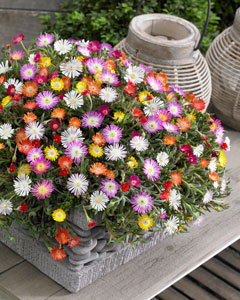12/27/2012
Delosperma That Shines Like a True Jewel
Blair Hoey

The Delosperma Jewel of Desert series is a breeding breakthrough for the delosperma species, commonly known as ice plant. These new genetics produce carpetlike mats of succulent foliage with neon-colored daisy-type flowers. Jewel of Desert is the result of new breeding from Koichiro Nishikawa of Japan, represented in North America by Concept Plants. These are a new generation of delosperma that will bloom continuously from spring until the first frost.
Jewel of Desert is a comprehensive series of six bright and neon-colored flowers including Ruby, Garnet, Topaz, Rosequarts, Peridott and Moonstone. Blooms are notable not just for their flower color, but for the intensity of the color. Flowering from late spring to the first frost, each can withstand the toughest environments and still shine like a true Jewel.
The plants reach only 4 to 6 in. tall and spread 8 to 10 in. in a ground-covering, carpetlike plant habit. Jewel of Desert varieties prefer full sun to partial shade. They offer superior drought tolerance.
With their cascading effect, Delosperma Jewel of Desert varieties are excellent plants for borders, rock gardens, or patio pots and planters. Plants are cold hardy to Zones 5 to 10.
Media & pH Delosperma Jewel of Desert varieties grow best in a clean, open-structure substrate with excellent drainage. The growing mix can have a slightly acidic pH range of 5.8 to 6.5. Any commercially available bark- or peat-based media is an excellent choice, as long as the mix provides for sufficient water-holding ability and most essentially allows for ample drainage.
Propagation These plants will root in four to six weeks at rooting temperatures of 68 to 72F (20 to 22C) if using URCs. Delosperma are succulent-type plants, so they root faster using minimum mist frequency and avoiding excessive wet periods.
Planting Rooted plugs of Delosperma Jewel of Desert can be used to finish either quarts (162 cells, 1 plant per pot) or gallons (72 cells, 1 plant per pot). For best results, when transplanting rooted plugs into the finished container, it’s important to plant the top of the plug even with the growing media—not below.
Temperatures Delosperma Jewel of Desert varieties do not need a cold period (vernalization) for blooming. Plugs can be planted in the fall using a smaller rooted input to allow for plant bulking and then overwintered, or planted in the early spring for later spring/summer sales. Once established, the plants can finish at 60 to 65F (15 to 18C) days and 55F (12C) nights. Spring finish times, which allow for plants to both bulk up and flower, will be eight to 10 weeks for quarts and 12 or more weeks for gallons.
Light requirements Delosperma thrive in full sun with a minimum of at least six hours of sunlight for active flowering.
Pinching & PGRs Rooted plugs should be pinched coming out of propagation. If planting unpinched rooted plugs, you can pinch plugs 10 to 14 days after transplanting. The series’ plant habit is tight and controlled, so no PGR applications will be required.
Fertilizer Delosperma are not heavy feeders, so fertilize with a constant liquid feed of 100 to 125 ppm or half rates of granular slow-release fertilizer can be incorporated into the soil prior to
transplanting.
Watering The Jewel of Desert series, like all delosperma, are part of a drought-tolerant species, so overwatering during production should be avoided. These varieties of delosperma perform best when grown by allowing the soil to dry moderately before the next irrigation cycle (wet/dry cycle) and avoiding waterlogged containers during
production.
Pest control There are no significant pest or disease issues associated with production of the Delosperma Jewel of Desert series. To avoid any potential insect or disease issues during production, maintain an active scouting program. As with any commercial production protocol, the series will benefit from a general-purpose pesticide and fungicide spray program during the production cycle, based on your scouting reports. Monthly preventative fungicide drenches are always recommended if necessary.
GT
Blair Hoey is New Product Development Manager and Western Regional Sales Manager for Northwest Horticulture. He can be contacted at blairhoey@northwesthort.com or (800) 459-3142. Visit www.northwesthort.com.